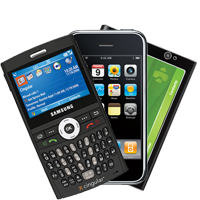 US cellular providers are starting to wake up to popular demand and bringing some more attractive hardware stateside. This, however, brings another problem for uneducated consumers – which cell phone to buy? Should I get a smartphone? Or PDA phone? Or regular cell phone and PDA separately? Would iPhone be everything I need or will I need some other piece of hardware? Which data plan should I get then?
US cellular providers are starting to wake up to popular demand and bringing some more attractive hardware stateside. This, however, brings another problem for uneducated consumers – which cell phone to buy? Should I get a smartphone? Or PDA phone? Or regular cell phone and PDA separately? Would iPhone be everything I need or will I need some other piece of hardware? Which data plan should I get then?
These are not some foreign questions, these are the questions that people keep asking their friends and friends of the friends – because they usually tend not to trust sales associates (who all work on commissions and tend to push whatever product brings the most profit). These are the questions I am myself being asked on a constant basis.
The breakdown, the way I see it, is as follows. If the only thing you need to do with a mobile device is talk, plus occasionally play some games on a subway – save your money and go with as fancy a cell phone as you want. After all, there’s little need to pay extra for features you will not or will hardly use. Cell phones, on the other side, produce better talk and standby times, somewhat better call quality and are cheaper to replace in case something happens. On a downside – in most cases cell phones require much additional effort to backup contacts and call information.
Smartphones (which I am not really a big fan of) are something of both worlds. This means both upsides and downsides. More functionality for a phone (it is a phone, after all) comes with a detriment to battery life, price and convenience. Additionally, the (poor) attempt to fit QWERTY keyboard into a cell phone frame leads to compromises that don’t benefit neither cell phone users nor PDA fans. Whatever those gadget freaks may tell you – the keyboard on the smartphone is the worst kind of input device there is. The bright side of the smartphone (at least the Samsung BlackJack that I use right now) is that it’s a fully functional Windows Mobile device fit into the size of the Motorola Razr, with whole contacts database, document reading and mobile internet connectivity included.
PDA phones are totaly different breed. Aside from Sidekick (which I have no idea of what it is), any PDA phone is first PDA and only then – phone. As a climax of such approach HTC developed its Advantage, which doesn’t even have a regular phone speaker – only the speakerphone. Latest variations of PDA phones (such as Shadow, Wing, ETEN X800/M800, etc.) are addressing PDA functionality adding GPS, WiFi, more CPU power and more memory. PDA phones are especially good if you don’t like to take your laptop with you, or – if you already did – save you the trouble of taking it out of the bag any time you have a spare minute. Besides, it fits much better when you are stuffed in the airplane or train seat. Of course, you take your contacts database with you (even with pictures), you may even work on spreadsheets (although I am not sure what can you spread on 320×240 pixels screen) and edit text documents. Additionally, you can be brave enough to surf the web with mobile IE or Mobile Opera, which is an eye-opening experience all by itself. Additionally, with PDA phone you can purchase data plan with ability to hook up your laptop (it’s also called laptop tethering by AT&T) via PDA to browse Internet. 3G speeds are pretty decent for full-featured e-mail and occasional browsing activities. The disadvantages of the PDA phone are short battery life, larger size and weight, and, obviously, the price. To me personally, however, they are much outweighed by many features a PDA phone has.
Blackberry is totally foreign universe to me, as I was never on board with all this corporate PDA use. Therefore I completely skip this device as I have no knowledge of it and never used it.
Summarizing the whole story, it all boils down to what you need to do with your phone. For occasional gaming and heavy talk use the regular cell phone is just perfect. For occasional e-mail exchange and some small typing the smartphone would probably be the best. If you need to be constantly connected to the web no matter what – the PDA phone is probably the best choice. By the way, do use the 14 days grace period to try out several devices to see which ones fit best into your daily routine.
 US cellular providers are starting to wake up to popular demand and bringing some more attractive hardware stateside. This, however, brings another problem for uneducated consumers – which cell phone to buy? Should I get a smartphone? Or
US cellular providers are starting to wake up to popular demand and bringing some more attractive hardware stateside. This, however, brings another problem for uneducated consumers – which cell phone to buy? Should I get a smartphone? Or